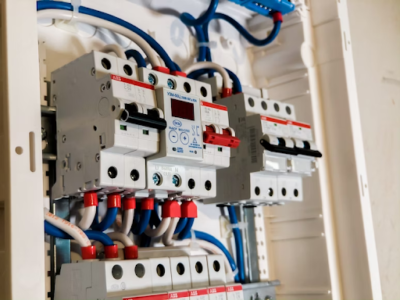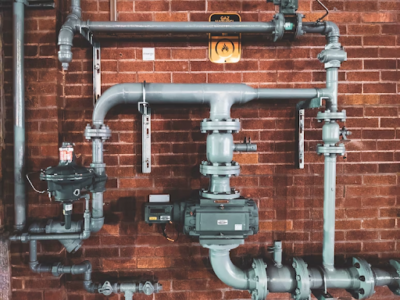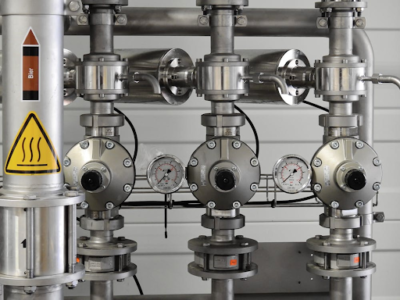In the ever-evolving landscape of commercial buildings, staying up-to-date with the latest advancements in electrical and plumbing technologies is essential. As businesses strive for efficiency, sustainability, and enhanced user experience, the integration of cutting-edge electrical and plumbing systems has become a top priority.
 This comprehensive guide discusses the latest trends shaping these industries, from smart building solutions and energy-efficient lighting to advanced plumbing systems and water conservation strategies.
This comprehensive guide discusses the latest trends shaping these industries, from smart building solutions and energy-efficient lighting to advanced plumbing systems and water conservation strategies.
Smart Building Solutions: A Paradigm Shift in Building Management
The rise of smart building technologies has transformed how commercial buildings are managed and operated. Intelligent systems encompassing lighting, HVAC, security, and more are integrated to enhance energy efficiency, occupant comfort, and overall building performance.
Automated lighting controls adjust the brightness based on natural light levels and occupancy, reducing energy consumption. Similarly, smart HVAC systems adapt to real-time occupancy and weather conditions, optimizing comfort and energy usage.
Energy-Efficient Lighting: Illuminating the Path to Sustainability
Energy-efficient lighting solutions are at the forefront of sustainable building practices. LED technology has revolutionized the lighting industry, providing a longer lifespan, lower energy consumption, and customizable lighting effects.
Moreover, advanced lighting control systems allow for precise adjustment of lighting levels based on usage patterns and daylight availability. This reduces energy costs and creates a more comfortable and productive environment for building occupants.

Renewable Energy Integration: Harnessing the Power of the Sun
Commercial buildings are increasingly embracing renewable energy sources, such as solar power, to meet their energy needs. Solar panels installed on rooftops or facades generate clean energy, reducing reliance on conventional power sources and lowering operational expenses. In addition to cost savings, adopting solar energy contributes to a greener image and aligns with corporate sustainability goals.
Water-Efficient Plumbing Systems: A Step Towards Conservation
Water efficiency is a driving force behind innovation in the realm of plumbing technologies. Low-flow fixtures, such as toilets, faucets, and urinals, significantly reduce water consumption without compromising functionality. Sensor-operated faucets and toilets further optimize water usage by delivering water only when needed. Moreover, greywater recycling systems capture and treat non-potable water for reuse in non-drinking applications like irrigation or toilet flushing, minimizing water waste.

Advanced Leak Detection: Preventing Water Damage
Undetected water leaks can lead to costly damages and operational disruptions. Advanced leak detection technologies utilize sensors and analytics to identify leaks in real-time, enabling prompt intervention. These systems can automatically shut off the water supply to the affected area, mitigating potential damages and preventing further water loss. By proactively addressing leaks, businesses can save money and conserve water resources.
Hybrid Plumbing Systems: Integrating Innovation
Hybrid plumbing systems combine traditional plumbing methods with modern technology to optimize water usage and efficiency. Greywater and rainwater harvesting systems collect and treat water from various sources for non-potable applications. By integrating these alternative water sources, businesses can further reduce their reliance on the municipal water supply, resulting in both cost savings and reduced environmental impact.
Electrical Grid Resilience: Powering Through Challenges
Commercial buildings are increasingly prioritizing electrical grid resilience to ensure uninterrupted operations during power outages or disruptions. This trend involves the implementation of backup power solutions, such as generators or energy storage systems. These systems automatically kick in during grid failures, providing essential power to critical areas of the building. Electrical grid resilience safeguards business continuity and enhances tenant satisfaction and safety.

Building Energy Management Systems (BEMS): Optimizing Energy Performance
BEMS technology allows centralized control and monitoring of a building’s energy consumption. It gathers data from various systems, such as lighting, HVAC, and appliances, and provides insights for optimization. BEMS enables real-time adjustments, load shedding during peak demand, and predictive maintenance, all of which contribute to energy efficiency and cost savings.
Water Quality Monitoring and Treatment: Ensuring Safe Consumption
Water quality stands as an unwavering priority within the realm of commercial buildings, bearing significant implications for health and safety. Addressing this concern head-on, advanced monitoring systems vigilantly and incessantly evaluate a spectrum of critical water quality parameters while swiftly identifying any potential contaminants. Moreover, implementing cutting-edge water treatment technologies, including UV disinfection and advanced filtration methods, serves as an impervious shield against lurking threats.
This meticulous approach ensures that every droplet of water destined for consumption by occupants is bestowed with the highest standards of purity, unburdened by harmful pathogens or impurities. By deploying these innovative water quality measures, businesses underscore an unwavering commitment to the well-being of their occupants while reinforcing an environment of trust and security.
Adaptive Plumbing Infrastructure: Flexibility for Changing Needs
Modern commercial buildings require adaptable plumbing systems to seamlessly accommodate the evolving needs of dynamic workspaces. Incorporating modular plumbing layouts and reconfigurable fixtures facilitates swift adjustments as spaces undergo repurposing or renovation, minimizing disruptions and optimizing functionality. This intrinsic adaptability enhances operational efficiency and contributes to a reduction in construction waste, demonstrating a commitment to responsible resource utilization.
Embracing such design principles aligns with sustainable building practices and future-proofs the infrastructure, ensuring that the plumbing systems can effortlessly evolve in tandem with the changing demands of the modern business environment.
Electrification of Heating: Transitioning to Sustainable Heating Solutions
The shift towards sustainable energy extends to heating systems, marking a significant stride towards a greener future. Embracing this transition, the electrification of heating entails a fundamental shift from conventional fossil fuel-based systems to innovative electric heat pumps. These technologically advanced pumps adeptly extract ambient heat from either the air or ground, converting it into a readily usable and efficient source of warmth.
Beyond the obvious energy savings, this transformative approach to heating underscores a profound commitment to environmental preservation, as it significantly curbs greenhouse gas emissions and aligns seamlessly with corporate sustainability objectives. The electrification of heating stands as a pivotal example of how cutting-edge technologies can harmonize with ecological responsibility to yield tangible benefits for both businesses and the planet.

As you navigate the dynamic landscape of commercial building technologies, consider Facilities USA as your partner. With a proven track record of delivering state-of-the-art electrical and plumbing repair and maintenance solutions, they’re dedicated to helping businesses prevent downtime due to electrical and plumbing issues. They also provide commercial waste management services, electronic disposal, emergency light testing, fluorescent bulb recycling, etc.
So what are you waiting for? Whether you need responsible electronic disposal solutions or want to repair your company’s pipes, get in touch with them at Inquiry@FacilitiesUSA.com for more details.
About the Author
The author is a commercial maintenance expert affiliated with Facilities USA. With tips like safe electronics disposal, he constantly encourages companies to be more sustainable, well-maintained, and customer-centric.
